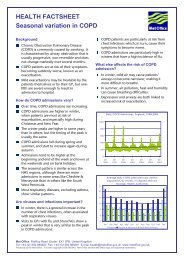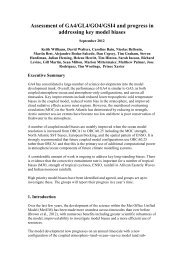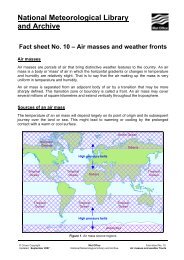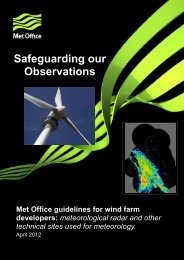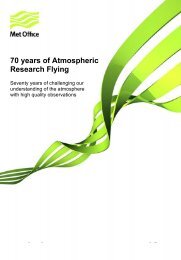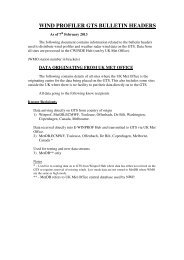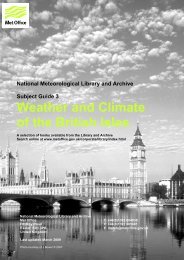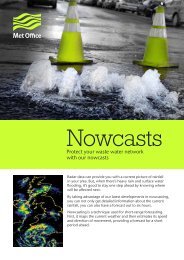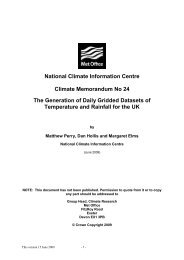Description and assessment of the OSTIA reanalysis. - Met Office
Description and assessment of the OSTIA reanalysis. - Met Office
Description and assessment of the OSTIA reanalysis. - Met Office
You also want an ePaper? Increase the reach of your titles
YUMPU automatically turns print PDFs into web optimized ePapers that Google loves.
There are a variety <strong>of</strong> o<strong>the</strong>r satellite-derived global SST products with different grid sizes, integration<br />
times, data selection <strong>and</strong> gap-filling strategies for cloud cover but, unlike Pathfinder, <strong>the</strong>y are<br />
derived for short-term operational requirements (Robinson, 2004).<br />
Subsequent versions <strong>of</strong> <strong>the</strong> PFSST algorithm have undergone improvements (Kilpatrick et al.,<br />
2001). The most recent version at <strong>the</strong> time <strong>of</strong> writing, Pathfinder v5.0, has been used for <strong>the</strong> <strong>OSTIA</strong><br />
<strong>reanalysis</strong> on a daily time period with a spatial resolution <strong>of</strong> 4 km on an equal-angle longitudelatitude<br />
grid (NODC, 2009).<br />
The actual definition <strong>of</strong> a ‘day’ employed in <strong>the</strong>se files not only encompasses a temporal component<br />
(e.g. 24 hours) but also a spatial one (e.g. full global coverage) (Kilpatrick et al., 2001). This is<br />
to avoid large discontinuities at <strong>the</strong> time or space boundary. The spatial component is defined as <strong>the</strong><br />
“time at which <strong>the</strong> satellite orbit track crosses <strong>the</strong> 180 o meridian nearest to <strong>the</strong> equator” (Kilpatrick<br />
et al., 2001). Using only <strong>the</strong> satellite orbit to define <strong>the</strong> start <strong>and</strong> end times <strong>of</strong> <strong>the</strong> data day would result<br />
in large discontinuities at <strong>the</strong> meridian boundary as <strong>the</strong> orbit precesses (Kilpatrick et al., 2001).<br />
To avoid this issue, <strong>the</strong> temporal component <strong>of</strong> <strong>the</strong> data day includes any data taken within 2 hours<br />
before or after <strong>the</strong> crossing <strong>of</strong> <strong>the</strong> meridian. Hence a data day in <strong>the</strong> Pathfinder files may include<br />
data over a 24 to 28 hour period (Kilpatrick et al., 2001).<br />
The AVHRR instrument uses three infrared channels to estimate SST located in wavelength regions<br />
where <strong>the</strong> atmosphere is relatively transparent (Kilpatrick et al., 2001). The accuracy <strong>of</strong> <strong>the</strong><br />
brightness temperature measurements from individual channels is between 0.1 K <strong>and</strong> 0.2 K (Robinson,<br />
2004). The entire surface <strong>of</strong> <strong>the</strong> Earth is viewed at least twice a day; once from <strong>the</strong> ascending<br />
(daylight) overpasses <strong>and</strong> once from <strong>the</strong> descending (night) passes (Robinson, 2004). The swath<br />
<strong>of</strong> adjacent orbits overlap significantly away from <strong>the</strong> tropics, meaning at high latitudes locations<br />
are observed several times a day (Robinson, 2004). Robinson (2004) gives full details <strong>of</strong> AVHRR<br />
instrument channels <strong>and</strong> NOAA satellite orbits.<br />
In <strong>the</strong> PFSST algorithm <strong>the</strong> SST assigned to each cell <strong>of</strong> <strong>the</strong> composite grid is based on <strong>the</strong><br />
average <strong>of</strong> all <strong>the</strong> samples obtained within <strong>the</strong> cell during <strong>the</strong> integration period, after cloud screening<br />
<strong>and</strong> atmospheric correction (Robinson, 2004). Robinson (2004) also notes that for pixels with<br />
scarce observations, <strong>the</strong> composite value may be biased by overdependence on too few overpasses<br />
or that <strong>the</strong> observations may not be spatially representative <strong>of</strong> <strong>the</strong> full width <strong>of</strong> <strong>the</strong> cell. The time<br />
<strong>of</strong> observation for each pixel is not provided as part <strong>of</strong> <strong>the</strong> dataset since <strong>the</strong> final SST value is a<br />
combination <strong>of</strong> multiple observations from that particular data day, <strong>and</strong> only those <strong>of</strong> <strong>the</strong> highest<br />
quality level available (see below). In addition, drift in <strong>the</strong> orbit times makes it difficult to associate<br />
an exact time with a particular observation throughout <strong>the</strong> measurement period (Kilpatrick et al.,<br />
2001).<br />
Version 5.0 <strong>of</strong> <strong>the</strong> PFSST algorithm includes <strong>the</strong> use <strong>of</strong> empirical coefficients which are revised<br />
every month throughout <strong>the</strong> data record to correct for slow changes in <strong>the</strong> detector response, drifts<br />
in <strong>the</strong> satellite orbit <strong>and</strong> variations <strong>of</strong> stratospheric aerosol. The coefficients are estimated using<br />
a regression <strong>of</strong> remotely sensed brightness temperatures on in situ temperature measurements<br />
© c Crown Copyright 2011 15




